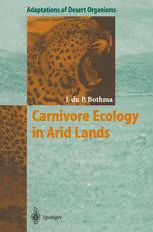
Carnivore Ecology in Arid Lands PDF
Preview Carnivore Ecology in Arid Lands
Adaptations ofDesert Organisms Editedby J.1.Cloudsley-Thompson Springer-Verlag Berlin Heidelberg GmbH Volumes alreadypublished Ecophysiologyofthe Camelidae Structure-Function Relations andDesertRuminants ofWarm DesertPlants ByR.T.Wilson (1989) ByA.C.Gibson(1996) EcophysiologyofDesertArthropods Physiological EcologyofNorth and Reptiles AmericanDesertPlants ByJ.L.Cloudsley-Thompson(l99I) ByS.D.Smith,R.K.Manson,and J.E.Anderson(1997) Plant Nutrientsin DesertEnviron ments EcophysiologyofSmallDesert ByA.Dayand K.Ludeke(1993) Mammals ByA.A.Degen (1997) SeedGerminationinDesertPlants ByY.Gutterman(1993) Homeostasisin DesertReptiles ByS.D.Bradshaw(1997) BehaviouralAdaptationsofDesert Animals EcophysiologyofAmphibians ByG.Costa (1995) InhabitingXericEnvironments ByM.R.Warburg(1997) InvertebratesinHot and ColdArid Environments AvianDesertPredators ByL.Sernme(1995) ByW.E.Cook(1997) EnergeticsofDesertInvertebrates CarnivoreEcologyinArid Lands ByH.Heatwole(1996) ByJ.du P.Bothma(1998) EcophysiologyofDesertBirds Inpreparation ByG.L.Maclean (1996) EcophysiologyofEconomicPlants inAridand Semi-AridLands PlantsofDesertDunes ByG.E.Wickens (1998) ByA.Danin(1996) ArthropodsofMediterranean-Type Biotic InteractionsinAridLands Ecosystems ByJ.L.Cloudsley-Thompson(1996) ByG.P.Stamou(1998) Jacobus du P. Bothma Carnivore Ecology in Arid lands With 18Figures , Springer Prof.Dr.[acobus du P.Bothma Centre for Wildlife Management Universityof Pretoria 0002 Pretoria Republic of SouthAfrica Frontcoverillustration: Pantherapardus(leopard).Photograph takenby J.du P.Bothma. ISSN1430-9432 LibraryofCongressCataloging-in-PublicationData Bothma,J.du P. Carnivoreecologyinarid landsIIacobusduP.Bothma. p. cm. -- (Adaptationsofdesertorganisms) lncludesbibliographicalreferencess (p, )and index. l.Carnivore--Ecology. 2.Aridregionsanimals--Ecology. 3.Carnivora--Adaptation. 4.Aridregions animals--Addaptation. I.Titel. 11.Series. QL737.C2B68 1998 599.71754--dc21 Thiswork issubject tocopyright.Allrights arereserved,whetherthewholeorpartofthe materialisconcerned,specificallytherightsoftranslation,reprintingreuseofillustrations, recitation,broadcasting,reproduction on microfilm or in any other way,and storage in data banks.Duplicationof this publication or parts thereofispermitredonly under the provisionsofthe German CopyrightLawofSeptember9,1965,initscurrentversion, and permissionsforusemustalwaysbeobtainedfromSpringer-Verlag.Violationsareliablefor prosecutionundertheGermanCopyrightLaw. ISBN978-3-642-08213-9 ISBN978-3-662-03587-0(eBook) DOI10.1007/978-3-662-03587-0 ©Springer-VerlagBerlinHeidelberg1998 OriginallypublishedbySpringer-VerlagBerlinHeidelbergin1998. Softcoverreprintofthehardcover1stedition1998 Theuseofgeneraldescriptivenarnes,registerednames,trademarks,etc.inthispublication does not imply,even in the absence ofaspecificstatement,that such names are exempt fromtherelevant protectivelawsand regulationsand thereforefreeforgeneraluse. Coverdesign:Design&ProductionGmbH,Heidelberg Camerareadyby:Emanuel Rachl SPIN10480341 31/3137-543210-Printedonacid-freepaper Acknowledgements Illustrationsfrom the followingsources havebeenused with kindper mission and are gratefullyacknowledged: Figure 2.4from Fanshawe etal.(1991);Fig.3.3from Stander(1992a);Fig.3.4from Cooper(1991) andFig.4.2from Tilsonetal.(1980);Fig.4.3from Richardson(1987b); Fig.4.4from Richardson(1987a)and Fig.5.2from Rasa(1989a).Other Figures are photographsbythe author. Sincere appreciationisalso expressedtoSpringer-VerlagGmbH & Co.KGfor involving me in this Series on the Adaptations of Desert Organisms,andspecialthankstoDr.AndreaSchlitzberger forherkind assistance.Prof.J.L.Cloudsley-Thompson has been an inspiration as adesertbiologistover many years.Heactedas akind advisorduring the preparation of this manuscript.His comments were invaluable. Mywife Babsie typed and prepared many drafts of the manuscript. Prof.Ee.Elofffirst introducedme to desertecology andcommented on variousdrafts.The Universityof Pretoriaallowed me time to pre pare the manuscript and helped in the preparation of the illustra tions used in the text.All these people and institutions are thanked warmlyand most sincerely. Pretoria,December 1997 ]. du P. Bothma Contents 1 Introduction . 1.1 The Approach Used 3 2 FamilyCanidae . 7 2.1 Taxonomy, Distribution,and Status . 7 2.2 Social Behaviour . 8 2.2.1 Group Formation . 9 2.2.2 Nomads . 12 2.2.3 Communication . 13 2.3 Reproduction . 15 2.3.1 Wild Dogs . 15 2.3.2 Jackals . 17 2.3.3 Foxes . 18 2.4 Area Use,Movements,and Activity . 19 2.4.1 Wild Dogs . 19 2.4.2 Jackals . 22 2.4.3 Foxes , . 25 2.5 Feeding Ecology . 26 2.5.1 Food . 27 2.5.2 Hunting and Foraging . 32 2.5.3 Killing . 34 2.5.4 Feeding . 35 2.5.5 Water UseandAdaptive Physiology . 37 2.6 Population Ecology . 38 2.7 Interactionwith OtherCarnivores . 39 2.7.1 Wild Dogs . 39 2.7.2 Jackals . 40 2.7.3 Foxes . 41 VIII Contents 3 Family Felidae 43 3.1 Taxomomy,Distribution,and Status ............... 43 3.2 SocialBehaviour. .............................. 46 3.2.1 Group Formation 46 3.2.2 Nomads. .... ... .. . . .. .. . 47 3.2.3 Communication ............................... 48 3.3 Reproduction 50 3.3.1 Lions ........................................ 51 3.3.2 Leopards ..................................... 53 3.3.3 Cheetahs. .................................... 55 3.3.4 Other Cats .................................... 56 3.4 Area Use,Movements,and Activity 57 3.4.1 Lions. ....................................... 57 3.4.2 Leopards. .................................... 59 3.4.3 Cheetahs ..................................... 61 3.4.4 OtherCats. ................................... 61 3.5 Feeding Ecology ............................... 63 3.5.1 Food. ....................................... 64 3.5.2 Hunting ...................................... 68 3.5.3 Killing. ...................................... 76 3.5.4 Feeding ...................................... 78 3.5.5 Food Passageand Defecation 81 3.5.6 WaterUse 81 3.6 Population Ecology 82 3.6.1 Lions. ....................................... 82 3.6.2 Leopards ..................................... 84 3.6.3 Cheetahs. .................................... 85 3.6.4 Other Cats .................................... 85 3.7 Interactionwith Other Carnivores 85 4 Family Hyaenidae 89 4.1 Taxomomy,Distribution,and Status. .............. 89 4.2 Social Behaviour ............................... 91 4.2.1 Group Formation ................ 91 4.2.2 Nomads ...................................... 96 4.2.3 Communication ............................... 97 4.3 Mimicry. ..................................... 103 4.3.1 PhysicalMimicry .............................. 103 4.3.2 SexualMimicry. ............................... 104 4.4 Reproduction. ................................ 105 4.4.1 SpottedHyaenas. .............................. 105 Contents IX 4.4.2 Striped Hyaenas 108 4.4.3 Brown Hyaenas ................................ 109 4.4.4 Aardwolves. .................................. 110 4.5 Area Use,Movements, andActivity 112 4.5.1 Spotted Hyaenas. .............................. 113 4.5.2 StripedHyaenas 118 4.5.3 BrownHyaenas ................................ 119 4.5.4 Aardwolves ................................... 120 4.6 Feeding Ecology. .............................. 121 4.6.1 Food ........................................ 122 4.6.2 Huntingand Foraging 128 4.6.3 Killing ....................................... 133 4.6.4 Feeding ...................................... 134 4.6.5 Defecation .................................... 138 4.6.6 Water Use 140 4.7 PopulationEcology 142 4.7.1 SpottedHyaenas. .............................. 142 4.7.2 OtherHyaenids ................................ 143 4.8 Interaction with Other Carnivores 144 4.8.1 Spotted Hyaenas ............................... .144 4.8.2 Striped Hyaenas 146 4.8.3 Brown Hyaenas. ............................... 146 4.8.4 Aardwolves ................................... 148 5 FamilyHerpestidae 149 5.1 Taxonomy,Distribution,and Status 149 5.2 SocialBehaviour ............................... 149 5.2.1 Group Formation .............................. 150 5.2.2 Communication. .............................. 152 5.2.3 Vigilance Behaviour. ........................... 153 5.3 Reproduction ................................. 155 5.3.1 DwarfMongooses 155 5.3.2 OtherHerpestids 157 5.4 Area Use,Movements, and Activity 158 5.4.1 DwarfMongooses 158 5.4.2 SlenderMongooses 159 5.4.3 Cape GreyMongooses 159 5.4.4 YellowMongooses andSuricates .................. 160 5.4.5 BandedMongooses 161 5.5 Feeding Ecology ............................... 161 5.5.1 Food. ....................................... 161 5.5.2 Hunting and Foraging. ......................... 163 x Contents 5.5.3. Killing,Feeding, and Water Use 164 5.5.4 Population Ecology 164 5.5.5 Interaction With OtherCarnivores. ............... 165 6 FamiliesMustelidaeandViverridae ............... 167 6.1 Family Mustelidae 167 6.1.1 Taxonomy, Distribution,and Status 167 6.1.2 The Honey-Badger. ............................ 168 6.2 FamilyViverridae .............................. 169 6.2.1 Taxonomy,Distribution,and Status 169 6.2.2 The Small-SpottedGenet ........................ 169 7 Synthesis ..................................... 171 7.1 The OrderCarnivora.. ........ .. ...... ........ . 171 7.2 SocialBehaviour. .............................. 172 7.2.1 Group Formation 173 7.2.2 Communication ............................... 174 7.3 Reproduction. ................................ 175 7.4 Area Use,Movements,and Activity 177 7.5 FeedingEcology ............................... 179 7.5.1 Food. ....................................... 179 7.5.2 Hunting and Foraging. ......................... 180 7.5.3 Killing ....................................... 182 7.5.4 Feeding ...................................... 182 7.5.5 Water Use 182 7.6 Population Ecology 183 7.7 Interactionwith Other Carnivores. ............... 183 7.8 Summary ..................................... 184 References ........................................... 185 Genus andSpecies Index ............................... 199 SubjectIndex 203
